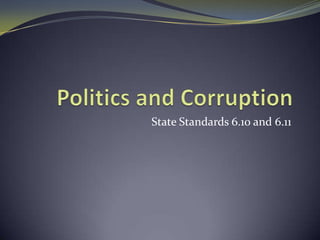
State Standards 6.10 and 6.11 Scandals and Reforms
- 1. State Standards 6.10 and 6.11
- 2. Black Friday Scandal First of three scandals under President Grant Gold Exchange Gold was a commodity that was traded and sold on the market James Fisk and Jay Gould Purchased enough gold so they could control its price on the stock market Controlling gold means more money for Fisk and Gould
- 3. Black Friday Scandal. Fisk and Gould’s friend Abel Corbin, President Grant’s brother in law Used Corbin to convince President Grant to not sell government gold This would lower the worth of the gold they purchased Grant learns of the plot Ordered the sale of 4 million dollars of government gold
- 4. Black Friday Scandal.. Because Grant decides to sale so much gold so quickly he caused a minor panic Black Friday of 1869 Panic happened investors had purchased gold on loans When the price of gold dropped they were unable to repay the loans Almost destroyed the economy
- 5. Credit Mobilier Scandal Union Pacific Railroad received government funding to build the transcontinental railroad Construction companies were supposed to bid on doing work for the Union Pacific Only one company, The Credit Mobilier, was ever given the contracts even though their prices were extremely high Excess money was kept by politicians and businessmen
- 6. Whiskey Ring Whiskey was taxed heavily by the federal government Distillers wanted more of the profit from these taxes Bribed politicians so that they did not have to pay this tax Secretary of Treasury Benjamin H Bristow Broke the Whiskey Ring Results in the indictments of over 200 people
- 7. Tammany Hall Tammany Hall Political organization in New York City “Machine” Politics Created a machine that ensured that Tammany Hall was always elected Bosses Networks of local leaders that helped communities get things they needed Citizens expected to respond with VOTES
- 8. Tammany Hall. Boss William Marcy Tweed Created a huge network for Tammany Hall Defrauded NYC of millions of dollars by creating companies to help the city and overcharging the city and keeping the profits Sent to jail in 1871 for defrauding the city
- 9. Compromise of 1877 1876 Presidential Election Rutherford B. Hayes vs. Samuel Tilden South upset Tilden didn’t win, North wanted Hayes to win In order to please the North and South the Compromise of 1877 was created 1. Established Rutherford B. Hayes as president 2. Ended Reconstruction in the South Federal troops were withdrawn from the South
- 10. Garfield’s Assassination Rutherford B. Hays promises he would only serve one term James Garfield wins the next election Garfield Wins a battle against Roscoe Conkling over the spoils system A system for appointing political supporters to government jobs
- 11. Garfield’s Assassination. Charles Guiteau Upset office seeker who did not receive an appointment to office by Garfield Shot President Garfield Resulted in a sever infection that killed Garfield 80 days later
- 12. Civil Service Reform Chester Arthur President after Garfield dies Spoils System Gave government jobs to political allies who may or may not have been qualified for that position Arthur wants to end the Spoils System Pendleton Act Established a Civil Service Commission which created a required examination for federal jobs Fewer jobs were handed out as political favors
- 13. Grangers (Populist) Granger Movement US farmers that fought Railroad monopolies Farmers who hated the Railroad Granger Laws Passed to regulate the railroads, proved the farmers did have political power
- 15. Interstate Commerce Act Interstate Commerce Act Required that railroads establish “reasonable and just” rates for consumers Established the Interstate Commerce Commission US Government’s first regulatory agency
